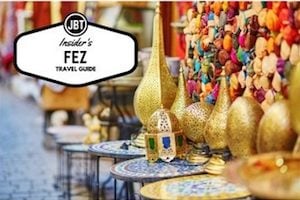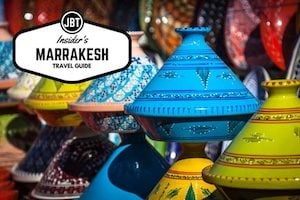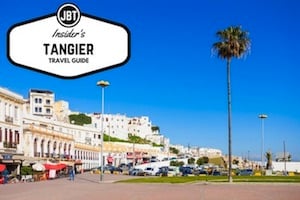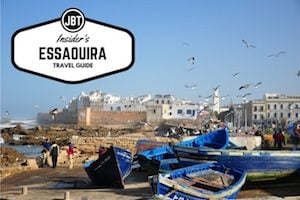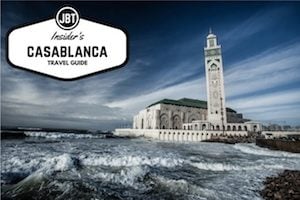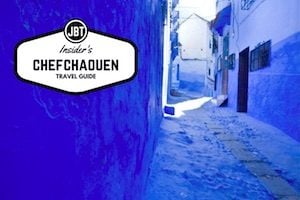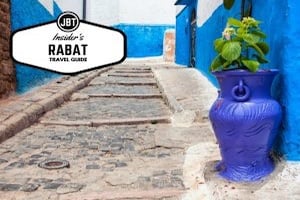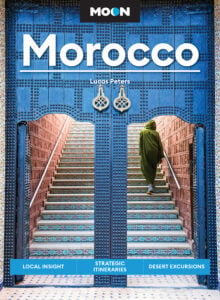There are many good reasons for the inquisitive traveler to visit Morocco. The High Atlas Mountains and their hiking trails. The old cities of Fez and Marrakesh with the largest traditional markets in all of Africa. And of course the impressive Roman ruins dotted throughout the country. Yes, you read that right. Roman ruins! In Morocco! The Roman ruins of Volubilis, Morocco, the finest of all the Roman ruins to be found in the country, are at once important for their Roman connections to the region, but for so many more reasons than that.

The ruins are fairly expansive, and a decent Morocco map or even just plenty of time to wander around makes this an area you can explore on your own without any need for a tour guide. The common Roman pillars keep the color of the desert, and are a reminder of how history united areas we might think of as totally separate today.
Today in Volubilis, though the grandeur of this city must largely be left to the imagination, there are several important buildings that have been reconstructed. You can wander beneath the Triumphal Arch of Emperor Caracalla after a stroll down Decumanus Maximus, the cobblestoned main thoroughfare. You can almost imagine hearing the marching of a Roman legion into the city. To your left, the remains of the most important public spaces; the Corinthian columns of the Capitoline temple, raised by a flight of thirteen steps; the Basilica, the courthouse and government administration, alongside which is the Forum, the 1,300 square meter market place, originally lined with temples, small public offices, and niches containing statues of emperors and local dignitaries. All with the backdrop of long, long vistas, once overflowing with olive groves, and wheat fields.

De-focus your eyes slightly and imagine the scattered stone blocks magically rising to form walls, the pillars assuming their rightful place at doorways and porticoes, with the tumbled acanthus leaf pediments topping them off. Roofs fly into place, shop doors and shutters appear. Slowly you begin to see movement as people go about their daily business. A donkey brays, cocks crow and the burble of conversation drifts on the wind from the market. The town comes to life, becoming more than just a pile of scattered ruins, but a living, breathing, thriving community.
Unlike many sites of Roman ruins, Volubilis wasn’t abandoned immediately. Part of the reason it remained in such good shape was that it remained an active settlement until the 1700s.
The Ancient History of the Roman Ruins of Volubilis
While many visitors wouldn’t think of a city in present-day Morocco being important to Rome, Volubilis was responsible for producing grain, which was used all through the entire Roman empire. The ruins of Volubilis are impressive and well known for the stunning mosaics that remain in excellent condition. The art of the mosaics is in surprisingly good shape and vivid colors—especially when considering these are ornamental artwork to fix up the floor! Now they are fenced off to prevent tourists from walking over them, but they are still easy to see and photograph.

This example of Roman art may at first glance seem out of place in Morocco, but to the contrary, the Berber tribes of southern Morocco were never conquered, but they traded with the Romans for the mutual benefit of both people. Latin even remained part of the local language until the Arab conquest introduced Arabic to the region!
Volubilis is undoubtedly the finest Roman ruin in the whole of Morocco, but before they set up camp in 45AD, when Emperor Claudius officially annexed North African Mauritania, a settlement of Carthaginian traders had been there for almost three centuries. In fact, Volubilis served as the capital city of the Kingdom of Mauritania before the Romans even arrived. When Volubilis was established as a Roman city, it was at the end of the imperial road. The Romans controlled one road primary road through Morocco that led to modern-day Tangier. Volubilis was one of Rome’s most remote outposts. Roman Legions at Rome’s command were never able to subdue the Berber tribes of the Atlas, and thus never able to expand south.
“Bread and Circuses” of the Roman Empire
In its heyday, Volubilis was an affluent provincial capital of around 20,000 people, its wealth based on the export of olives, olive oil and wheat to Rome, and wild animals to face the gladiators in arenas throughout the Roman Empire. It’s said that during their two hundred year occupation not only was Volubilis one of the gems of the Roman Empire in North Africa, but it was also the site of a major ecological disaster. Vast swathes of forests were cleared to create space to grow the enormous quantity of wheat needed to meet the annona, the free grain allowance that was every Roman citizen’s basic right. Bakeries and flour mills were some of the principle businesses for which we have discovered evidence in Volubilis. Over sixteen bakeries, twenty mills, and numerous granaries have been unearthed, spread throughout the city.
Meanwhile, the hunting of wild animals for gladiatorial games nearly drove indigenous species — such as the Atlas Bear and the Barbary Lion — into extinction. Both sides of the ‘bread and circuses’ coin by which the emperors controlled the population.
The value of olive oil to the commercial viability of the city is shown by the fact that fifty-eight oil presses have been discovered, and some of the grandest mansions even had their own. As well as its culinary uses it was used for lamps, medicinal purposes and for cleansing while bathing. The residue of the olives from the pressing was used as animal feed or dried to provide fuel for the bathhouses. Like most Roman cities, Volubilis had a complex water system that flowed below the Decumanus Secundus, (a street that ran parallel to the main thoroughfare) from a spring in the hills behind the city and supplied baths and houses, while a series of drains flushed waste water and sewage into the nearby river.

The importance of Volubilis is displayed in the beauty of its buildings. The Basilica, in its time one of the finest Roman basilicas in Africa, originally had two floors, and was the hub of the city’s legal administration. Beside it, the Capitoline Temple held great sway in public life as it was dedicated to the Roman state’s triumvirate of divinities; Jupiter, King of the Gods and god of sky and thunder; the warlike Juno, protector and special advisor to the state; and Minerva, goddess of wisdom and sponsor of arts, trade, and defence. Assemblies would be held before it to call on the gods for aid or to thank them for the successful completion of the more important civic undertakings, one of the primary ones being fighting wars.
The Decumanus Maximus was the commercial heart of Volubilis, (and also the best address). A grand paved avenue, it had arcaded porticoes shading its sidewalks on either side, and dozens of shops for the residents of this upper class neighbourhood to browse during their daily promenade. You will occasionally see small stone blocks with images carved on them scattered on the ground; these would have been the shop’s sign, to indicate its wares.
Volubilis After the Romans
A little over two centuries later after its annexation, into the Roman Empire, Volubilis began to lose its place in the region. Roman collapsed. While the empire was nearly entirely disintegrated through internecine warfare, assassinations, and palace coups, a few Volubilian citizens, aware of the upheaval, buried their hoards of money and fine bronze statues under their villas for safekeeping. These objects only saw the light of day, 1,700 years, later when they were unearthed by archaeologists.
That said, the fall of the Roman Empire did not spell the end of the Volubilis. When the Arabs first arrived in 708 they found it peopled with Greeks, Berbers, Christians and Jews, many of them descendants of those who had fled the persecutions and heavy taxes of the late Roman Empire.Latin was still the lingua franca of the city.
In fact, Moulay Idriss, the founder of what we know as modern Morocco, first sought refuge in Volubilis. Because he was a direct descendent of the Prophet Muhammed, Idriss was a threat the Abbassid dynasty, who were trying to assassinate him. Idriss fled from the Middle East and across the Sahara before finding some peace in Volubilis in 789. Idriss married Kenza of the Awraba Amazigh tribe. Idriss and Kenza had Idriss II. This was the start of the first Moroccan dynasty, the Idrissids. Eventually, the reach of the Abbassids proved too long. Idriss was assassinated in 791.
Very near to Volubilis is Moulay Idriss, the most important Islamic city in Morocco and final resting place of Moulay Idriss. When visiting Moulay Idriss, while this small city has many beautiful sites, be careful and respectful of religious traditions. This city is sacred to Muslims, and non-Muslims are not allowed into religious or holy areas. There are guides who are willing to get you as close as is polite to help you around, and this is a good idea for this area. Remember that you are a visitor, and it is always good to be respectful. In fact, it wasn’t until just a few decades ago that non-muslims were even allowed to enter the city!
The Jewels of the Roman Ruins of Volubilis That Remain
It’s behind these shops, in the mansions of the city’s elite, that some of the jewels of Volubilis can be found, the mosaics with their dominant themes of Greek myths that make this Roman outpost so important, (although a significant scene can be found in the House of the Athlete near the triumphal arch, a mosaic that depicts an athlete facing the wrong way on horseback having been awarded a prize in a ‘desultory race’; not a lethargic race, though, as a ‘desultor’ was an equestrian acrobat of the Roman circus whose specialty was jumping from one horse to another or standing astride two horses at full gallop).

Look for the solitary cypress tree to the east of the Decumanus Secundus and follow the narrow streets between the memory of walls that were once the homes of the rich and notable, and you arrive at the House of Venus, one of the most luxurious residences in the city. The mosaic for which the house is named is now in a museum in Rabat, but two extant mosaics show the sensual side of the art. The Abduction of Hylas by Nymphs shows Hylas, Hercules’ ‘companion’, dressed in nothing more than a deep orange robe and a headful of cascading blonde locks, being abducted by two water nymphs, a theme that has endured in Western classical art, while the slightly more salacious mosaic shows the Diana, goddess of the hunt, being surprised by the hunter Actaeon while bathing. Actaeon was probably equally surprised when the goddess punished him by turning him into a stag. Unable to explain his predicament to his hunting friends he was tracked down by his own dogs and killed. Perhaps it would have been if she had used a bigger towel.
As grand as the ruins of Volubilis are, they would have been grander still but for two events; the 17th century pillaging of the site by the Sultan Moulay Ismail for marble columns and artistic architecture to adorn his sumptuous palaces in Meknes, and the earthquake in 1755 that flattened Lisbon and left Rabat’s Hassan Mosque as little more than rows of pillared stumps.
Between the ruins and the holy city of Moulay Idriss, only a couple miles apart, sit two amazing symbols of the importance of the past, and the importance of the present. While maybe this wasn’t what you first envisioned when beginning trekking in Morocco, it certainly teaches even the experienced traveler to keep their eyes, minds, and hearts open to every destination a visited land has to offer, especially when it is a land of history such long, interweaving, complex history as Morocco.
Today, the Roman Ruins of Volubilis, Morocco sport a new museum dedicated to uncovering the importance of this UNESCO World Heritage Site.
JBT’s Morocco UNESCO World Heritage Series
Are you interested in discovering the other UNESCO World Heritage Sites found around Morocco? There are nine of them in total! Begin your exploration here:


